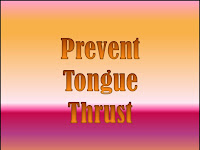Tongue Thrust Part 2: Prevention
Parents, Early Childhood and PK teachers and SLPs…this blog is written especially for YOU!
As previously established, a tongue thrust is an abnormal swallow pattern where one’s tongue pushes against or between the front teeth during a swallow.
“The average person swallows 2000-4000 times per day and exerts pressure of about 1-6 pounds with each swallow”, according to OraCare Peridontal Clinic . Therefore, chronic use of a tongue thrust can have negative impacts on one’s dentition as well as speech production.
Typical Swallow Pattern Development:
Infants tend to use a tongue thrust swallow pattern which gradually changes to a typical swallow pattern (i.e. where one’s tongue does NOT touch frontal teeth before, during, after swallow and at rest) by the time they are ready to finish Kindergarten (around 6 years of age). However, not all children naturally develop a typical swallow pattern. And the question then is “why?”
So what can a parent do to prevent tongue thrust?
1. Eliminate thumb/finger sucking. There are several techniques out there to eliminate thumb/finger sucking, so I won’t go into them here, but keep in mind the longer your child uses this behavior the longer a forward tongue placement will be reinforced and become habitual.
2. GET RID OF THOSE BOTTLES, PACIFIERS, and SIPPY CUPS ASAP!!! I cringe when I see 3 and 4 year olds walking into preschool or early childhood classrooms with a bottle, pacifier or sippy cup in their mouths! I understand this is more prominent in various cultures but for your child’s sake, please get rid of those artificial “nipples” as soon as possible. Why is it so bad you ask?
Fellow Blogger and SLP, Nanette Cote at speech2me, explains this so beautifully, I don’t think I could do a better job so I will quote her here:
“A Sippy cup is a bottle in cup form, meaning it requires the use of an immature, effortless, suckle pattern. This is fine for the young child, but by one year old, your child should be graduating to open cup and straw drinking. A suckle pattern means that your child needs to stick his or her tongue out of the mouth to drink. There is little to no tongue retraction involved in this movement. Most of the time, the liquid will drip out of a Sippy if you turn it upside down. Prolonged use of a bottle or Sippy cup may promote poor tongue posture. As a result, you will notice your child’s tongue rest outside of the mouth and you may observe difficulty with production of sounds made inside the mouth along the palate (t, d, k, g.). This can be especially true for any child with low tone and/or reduced awareness around the mouth.”
Keep in mind that pacifiers as well, have the same effect and should be discarded as soon as possible. Although, there is research to support pacifier use particularly at nighttime for a child’s 1st year of life to decrease risk of SIDS and ear infections, beyond a year there is no medical benefit. The earlier removal of a pacifier, the easier a transition it will be.
The next step is to move directly into straw drinking! Do this as soon as you possibly can! Why, you ask?
Nanette Cote (at speech2me) has that answer as well:
“Straw drinking promotes tongue retraction into the mouth while drinking. In order to suction liquids or shakes from the cup, you must pull your tongue into your mouth, which, by the way, is the area where your tongue needs to touch in order to produce many speech sounds including (t, d, k, g.) You can also mix things up a little by varying the intensity of the straw. Shorter straws and thin liquids are a great starting point for young children just getting used to this magical tool, while longer or twisty, silly straws in thicker liquids require more work. The latter version challenges older children to improve oral motor awareness. In other words, drinking cold, thick beverages with the straw pictured above may help your child feel where their lips and tongue are in the mouth, thus improving awareness for sound placements.”
Click here for Nanette’s full blog titled, The Powerful Straw!
So parents…here’s the plan!:
1. Throw out those bottles, sippy cups and pacifiers
2. Buy straws!
3. Start with thin liquids (juices, water) and a short straw. Once your toddler can do this…
4. Move on to longer straws with thin liquids.
5. Twisty straws with thin liquids.
6. Thicker liquids (smoothies, milkshakes (I do love Wendy’s Frosty for this!!!), etc.)…start with short straw and work your way up.
Remember straw drinking will strengthen your child’s tongue while supporting tongue placement INSIDE the oral cavity. This SIMPLE action can PREVENT the use of tongue thrust which can negatively affect dentition and speech production!
Click here to learn more about assessment and remediation of tongue thrust!
Sooooo….go buy your straws…drink up and as always…Happy Talking!!!
- ASHA: http://search.asha.org/default.aspx?q=pacifiers%20tongue%20thrust
- International Association of Orofacial Myology www.iaom.com
- Center for Speech and Language Pathology: http://www.speechtherapyct.com/whatsnew.htm (scroll down to Myofunctional Therapy)
- Super Duper: http://www.chattermattersslp.com/upload/27_tongue_thrust.pdf
- www.dentistry.com

Trackbacks/Pingbacks
[…] Below is information regarding remediation of tongue thrust. Click here for further information on prevention and assessment. Firstly, lets define what exactly is a tongue thrust. A tongue thrust occurs […]
[…] that we know what causes tongue thrust, how to prevent, and how to remediate tongue thrust, its time to review how to perform a tongue thrust […]